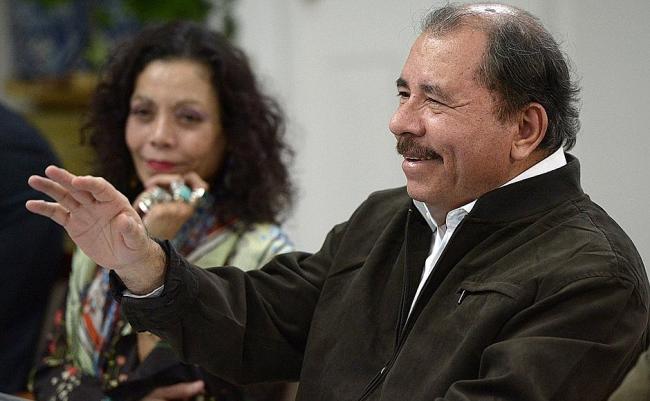Nicaragua’s Authoritarian Turn is Not a Product of Leftist Politics


Political repression in the country has its roots in U.S. intervention.
Jennifer Goett and Courtney Desiree Morris
09/16/2016
Nicaraguan president Daniel Ortega and his wife and vice presidential candidate Rosario Murillo on a state-visit to Russia (Wikimedia Commons)
On July 29th, Sandinista President Daniel Ortega unseated 16 opposition members and 12 alternates from Nicaragua’s legislature, eliminating one of the few remaining obstacles to one-party rule. Days later, Ortega named his wife, Rosario Murillo, as his vice presidential running mate for the November elections. Political analysts
inside and
outside of the country see the move as an attempt to secure a line of family succession, as Ortega, 70, enters the final years of his political career. Both Ortega and Murillo are members of the Sandinista National Liberation Front (FSLN), which overthrew the U.S.–backed Somoza family dictatorship in 1979. Ortega led the country from 1985 until the Sandinista electoral defeat in 1990, returning to power after a long hiatus in 2007. After successfully backing a
constitutional reform to remove term limits, he won the presidency for a third time in 2011.
The recent events in Nicaragua have garnered attention from mainstream media outlets in the U.S., decades after international press corps flocked to the country to cover the Sandinista Revolution and the Contra War that followed. While Nicaragua has faded from public consciousness, old political narratives about the country and the Latin American Left die hard. Nowhere is this more evident than the recent
New York Times editorial,
‘Dynasty,’ The Nicaragua Version.
Authored by the
Times editorial board, the piece tells a story that reflects U.S. political interests as well as a good deal of amnesia about our country’s history of intervention in Nicaragua. Focusing on the corruption of the Latin American Left as an explanation for rising authoritarianism, the board laments the democratic deficit that now exists in the country. The analysis, steeped in a heady dose of American exceptionalism, omits U.S. efforts to squelch democratic aspirations in Nicaragua and misses the true tragedy of events: Ortega’s betrayal of the revolutionary Left and the vision of a more just society it represented.
U.S. intervention in Nicaragua began in the 19th century, setting the stage for political instability and violence in the 20th century. Aspirations for an interoceanic canal route in Central America drove early U.S. interests in the region. After the U.S. opted for the more favorable Panamanian route, the Marines occupied Nicaragua from 1912 to 1933, in part to avert competing canal proposals that might weaken their monopoly to the south. Nicaragua’s Augusto César Sandino mounted a guerrilla opposition to the occupation in 1927. To help quash the rebellion, the U.S. armed, trained, and expanded the Nicaraguan National Guard. Anastasio Somoza García headed the organization and used its coercive power to establish one of the most enduring family dynasties in Latin America. After orchestrating Sandino’s assassination, Somoza established an expansive system of political patronage, isolating opponents and maintaining firm control over Nicaraguan civil society. His sons, Luis and Anastasio Somoza Debayle, took the reins of power after their father’s assassination in 1956.
U.S. occupation and support for the Somoza regime bestowed on Nicaragua a deep and enduring experience of political repression. It is no wonder that FSLN founder Carlos Fonseca identified U.S. imperialism as the driving force behind authoritarianism in the country. Inspired by Sandino’s struggle for national sovereignty in the 1920s, the FSLN emerged in the 1960s as a homegrown response to dictatorship and imperialism. The improbable success of the Sandinista Revolution initiated a period of political transformation, as Nicaragua attempted to forge a new society, grounded in political pluralism and democratic participation, which served the interests of its most vulnerable sectors.
Sandinista state policy reflected these commitments with agrarian reform, expansions in health services, and a national literacy campaign that brought a generation of youth to the countryside to teach rural families to read. The revolution infused new social and democratic energies into political life, and popular participation in revolutionary organizations burgeoned.
No single factor explains the 1990 electoral defeat that brought the Sandinista Revolution to a close. Certainly, the fledgling Sandinista state made significant errors as it sought to remake the highly unequal society it inherited from the Somoza regime. The Sandinista’s early
approach to governing indigenous and Afro-descendant communitieson the Caribbean coast was one of the most serious. But these missteps are overshadowed by the tremendous resources and energy the U.S. dedicated to sabotaging the revolution. As Nicaraguan poet and former Sandinista Gioconda Belli writes in her memoir of the revolutionary years, “I will never cease to be appalled at the utterly venomous, unwarranted manner in which the United States acted toward a tiny country that simply tried to do things its own way, even if this meant making its own mistakes.” A massive propaganda campaign against the revolutionary state paired with diplomatic pressures to isolate the country were followed by $400 million USD in
aid to the Contra insurgency,
the mining of Nicaraguan harbors, and
a debilitating U.S. trade embargo. The New York Times covered the destabilization campaign extensively, making the editorial board’s claim that “allegations of corruption” led to the Sandinista electoral defeat appear myopic at best.
War weary and suffering scarcity and economic crisis by the late 1980s, the Nicaraguan people sought relief in the democratic process. But beyond the respite from war, the average Nicaraguan did not fare well after the revolution. U.S. intervention persisted, now through the mechanism of development and “Washington Consensus” reforms. The Sandinista government inherited $1.6 billion USD in debt from the Somoza regime. Burdened by economic sanctions and defense spending during the war, the country’s debt had grown to
$10.8 billion USD by the end of the revolution. The economy stabilized with International Monetary Fund oversight, but poverty and unemployment rates remained high and popular sectors bore the brunt of austerity, privatization, and economic adjustment policies. Meanwhile, the national economy staggered under a growing debt burden that necessitated debt relief through the
Heavily Indebted Poor Countries (HIPC) program in the mid-2000s. This period of free market reform, sociologist William Robinson contends, resulted in a process of class restructuring that concentrated wealth in the hands of the Nicaraguan elite and multinational corporations.
It was during these difficult years that Ortega’s betrayal of the revolutionary Left began in earnest, as he molded the Sandinista Party into a vehicle to advance his own interests. The transfer of power from the revolutionary state to the center-right coalition led by President Violeta Chamorro was marred by
the appropriation of public funds and properties by outgoing officials, Ortega included. These acts of plunder, popularly referred to as the Piñata, paved the way for the development of a powerful Sandinista business class. Another key moment of alienation occurred in 1998 when Murillo’s daughter, Zoilamérica Narváez,
accused Ortega of sexually abusing her as an adolescent. The feminist Left rallied in support of Narváez, but Murillo chose to side with Ortega, cementing her position as his second-in-command. Once it became clear that the popular vote alone would not be a viable strategy to regain the presidency, Ortega engineered his return to power by changing electoral laws, aided by
quid pro quo pacts with right-wing caudillo Arnoldo Alemán. The coup de grace was Sandinista support for a
total abortion ban, which established Ortega’s alliance with the Christian Right in the run up to the 2006 elections that returned him to power.
 BASSE-TERRE – Rising crime in the French overseas department of Guadeloupe has prompted France to send in police reinforcement.
BASSE-TERRE – Rising crime in the French overseas department of Guadeloupe has prompted France to send in police reinforcement.




 Jumped the gun brehs dude was from Dominica
Jumped the gun brehs dude was from Dominica
 @ZoeGod
@ZoeGod  It's facts
It's facts



